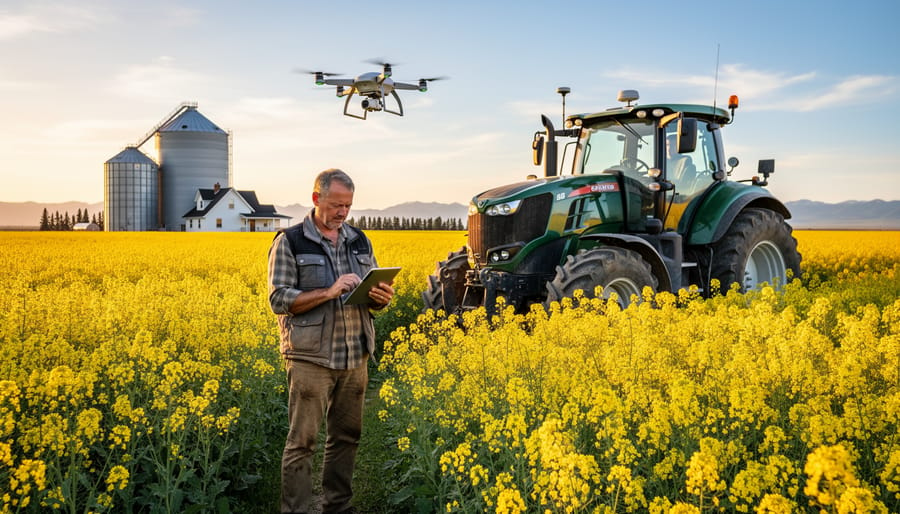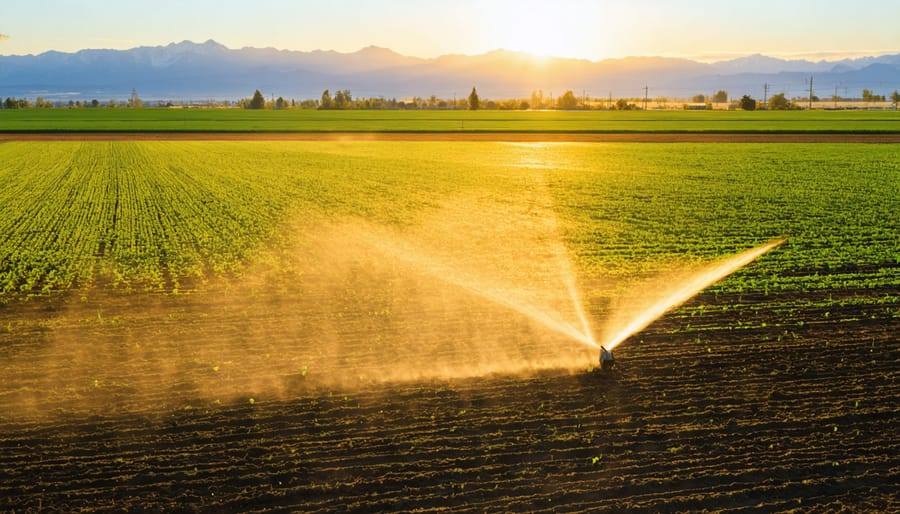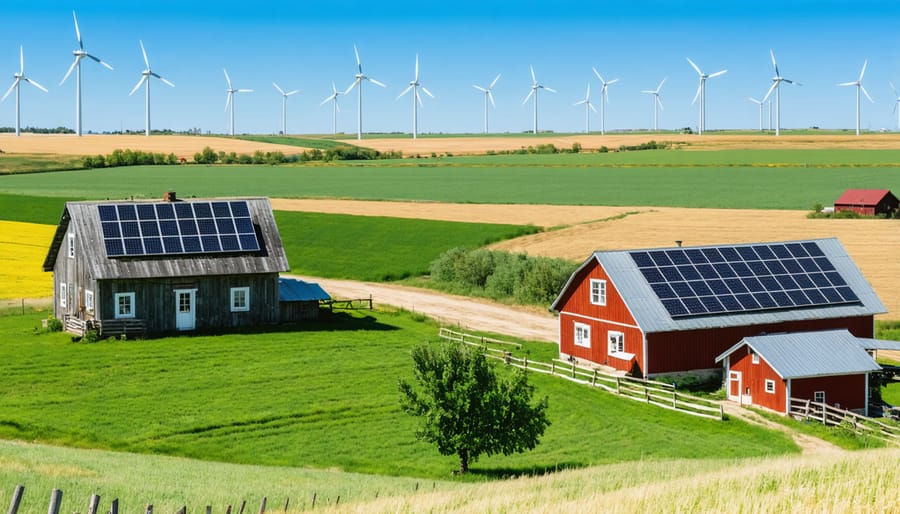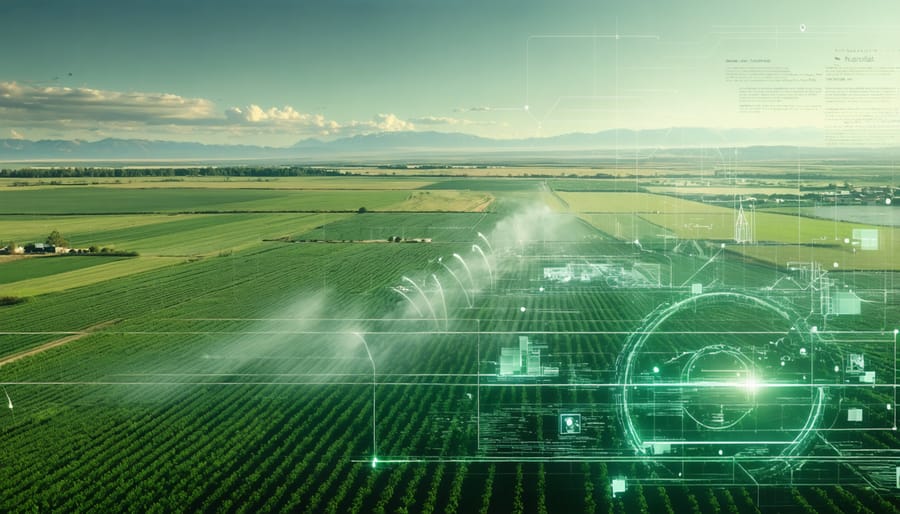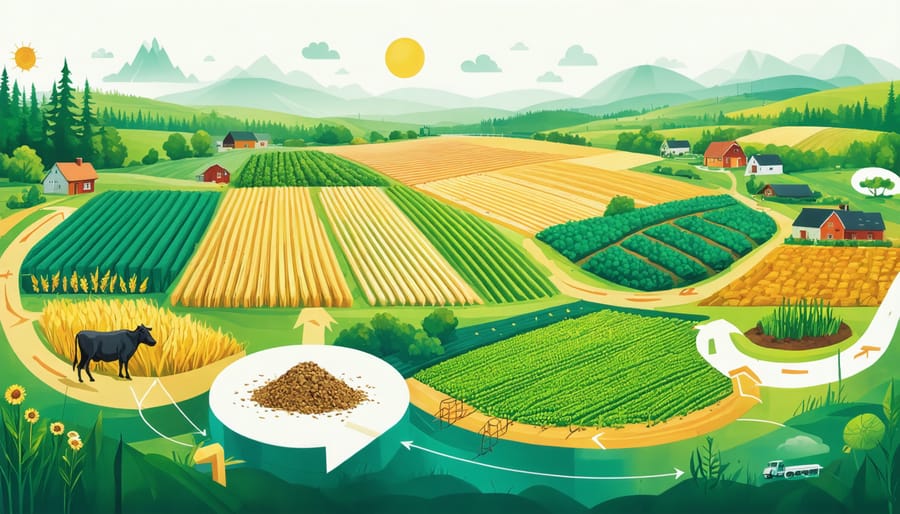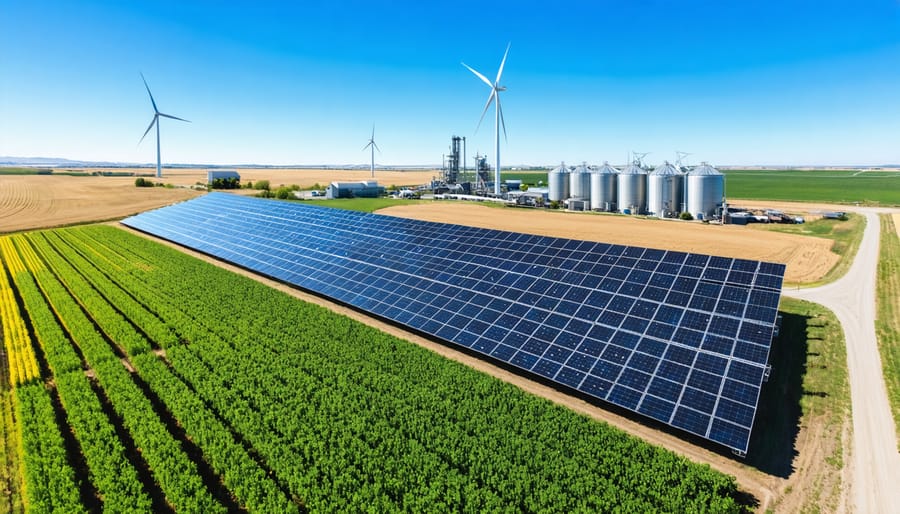Agroforestry transforms traditional farming landscapes into resilient, multi-layered ecosystems where trees, crops, and livestock work in harmony to maximize land productivity. Across Alberta’s diverse agricultural regions, farmers are discovering how this integrated approach creates natural buffers against market volatility while generating multiple income streams throughout the year. By strategically combining woodlots with conventional crops, agricultural operations can capture additional revenue through timber, fruits, nuts, and specialty products while simultaneously improving soil health and biodiversity.
These systems prove particularly valuable for Canadian producers facing increasing climate uncertainties and input costs. Research from the University of Alberta demonstrates that agroforestry practices can increase overall farm productivity by 40-60% compared to conventional single-crop systems, while reducing the need for synthetic fertilizers by up to 30%. For Alberta farmers, the integration of shelterbelts and silvopasture techniques has shown remarkable success in protecting livestock, enhancing crop yields, and creating sustainable income opportunities that strengthen rural communities.
Whether you’re managing a small family farm or overseeing large-scale operations, agroforestry offers practical solutions for diversifying revenue streams while building environmental resilience. The key lies in selecting locally-adapted tree species and designing systems that complement existing agricultural activities, creating a balanced approach to land stewardship that benefits both the farmer and the ecosystem.
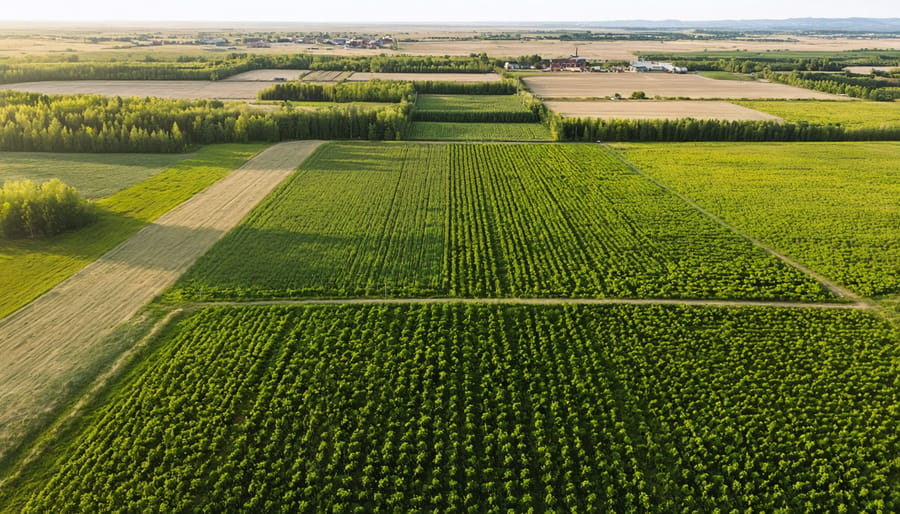
The Economic Power of Trees on Your Farm
Diversifying Farm Income
Agroforestry offers multiple revenue streams that can significantly enhance farm profitability. By implementing diverse profitable farming strategies, producers can create year-round income opportunities while building resilient agricultural systems.
Timber production serves as a long-term investment, with species like spruce and poplar offering substantial returns after 20-25 years. Meanwhile, fast-growing varieties like hybrid poplars can provide intermediate harvests every 5-7 years for pulpwood or biomass markets.
Fruit and nut production presents immediate to medium-term income potential. Saskatoon berries, hazelnuts, and sour cherries are well-adapted to Alberta’s climate and can begin producing within 3-5 years of establishment. These crops often command premium prices at farmers’ markets and through direct-to-consumer sales.
Non-timber forest products like mushrooms, medicinal herbs, and decorative materials provide supplementary income throughout the growing season. Many Alberta farmers have found success cultivating chaga mushrooms and wild ginseng under existing forest canopy.
Emerging carbon markets and ecosystem service payments are creating new revenue opportunities. Several Alberta farmers now receive compensation for carbon sequestration, watershed protection, and biodiversity enhancement through their agroforestry practices.
By stacking these various income streams, farmers can reduce their reliance on single commodities while building more financially stable operations that benefit both their bottom line and the environment.
Reducing Operating Costs
Implementing agroforestry systems can significantly reduce farm operating costs through several natural mechanisms. By strategically integrating trees and shrubs with crops, farmers create beneficial relationships that minimize the need for expensive external inputs.
One of the most substantial cost savings comes from natural pest control. Trees and shrubs provide habitat for beneficial insects and birds that prey on crop pests, reducing or eliminating the need for chemical pesticides. For example, Alberta farmers who’ve incorporated shelterbelts report up to 60% reduction in pest control expenses.
The tree-crop integration also contributes to improving soil health naturally, decreasing fertilizer requirements. Deep tree roots bring up nutrients from lower soil layers, while leaf litter adds organic matter to the topsoil. Many Alberta farmers report cutting their fertilizer costs by 30-40% within three years of establishing agroforestry systems.
Water management costs also decrease as trees improve soil structure and water retention. This natural irrigation support can reduce irrigation needs by up to 25%, particularly beneficial during dry Alberta summers. Additionally, windbreak effects from strategically placed trees reduce crop damage and water loss from evaporation.
The initial investment in establishing agroforestry systems typically pays for itself within 3-5 years through these reduced operating costs, while providing long-term financial benefits through sustained input savings and increased crop resilience.
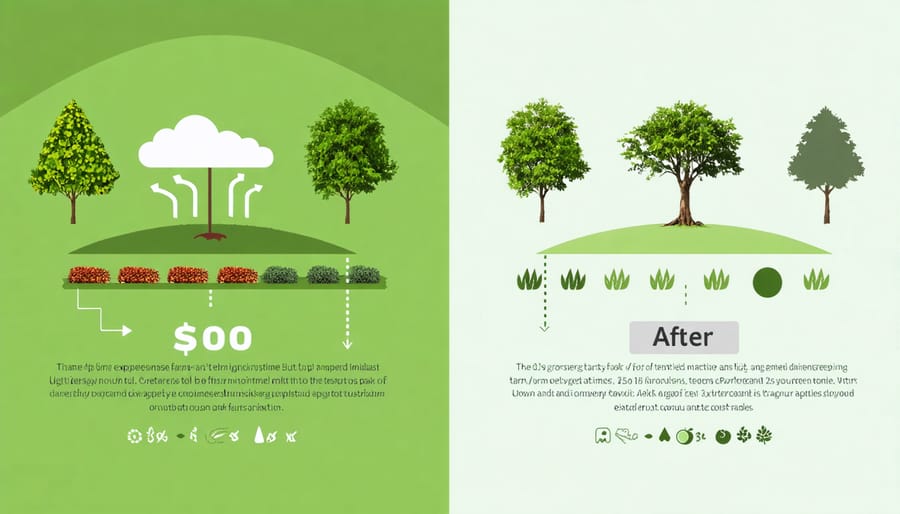
Proven Agroforestry Models for Alberta
Shelterbelts That Pay
The Johnson family farm in Lacombe County stands as a testament to the financial potential of well-designed shelterbelts. Over the past fifteen years, their strategic planting of hybrid poplar and white spruce has generated an additional $12,000 annually through wood products and increased crop yields.
“We initially planted the shelterbelts to protect our crops from wind damage,” explains Sarah Johnson, “but we’ve discovered multiple revenue streams we hadn’t anticipated.” Their three-row shelterbelt system includes fast-growing poplars for periodic harvest and white spruce for long-term windbreak benefits.
Field studies conducted by Alberta Agriculture show that farms with established shelterbelts experience 15-20% higher yields in adjacent crops due to improved moisture retention and reduced wind damage. For the Johnsons, this translates to approximately 8 extra bushels per acre on their canola fields.
Beyond traditional benefits, innovative farmers are finding new markets. Local furniture makers now pay premium prices for mature poplar wood, while Christmas tree sales from pruned spruce provide seasonal income. The Johnsons also collect and sell poplar bark to local herbalists and craftspeople.
The initial investment of $5,000 for seedlings and installation has paid for itself many times over. “The key is thinking long-term and diversifying your shelterbelt products,” Sarah advises. “It’s not just about protecting crops anymore – it’s about creating multiple income streams from the same land.”
Silvopasture Success Stories
The Ruzicka family farm in Fairview, Alberta, stands as a shining example of silvopasture success. Over the past decade, they’ve integrated hybrid poplar windbreaks with their cattle operation, reporting a 15% increase in calf survival rates during harsh winters and a 20% improvement in pasture productivity due to enhanced soil conditions and wind protection.
In Red Deer County, the Thompson Ranch has demonstrated how strategic tree placement can create microclimates that extend the grazing season by up to three weeks. Their carefully planned silvopasture system includes white spruce and trembling aspen, providing shelter for their Angus herd while generating additional income through sustainable timber harvesting.
The Lakeland Agricultural Research Association (LARA) pilot project near Bonnyville showcases how willow and buffalo berry integration can provide supplementary feed during drought periods. Participating farmers have documented a 25% reduction in winter feed costs and improved cattle weight gain during summer months.
Perhaps most inspiring is the multi-generational Brooks family operation near Grande Prairie, which has successfully combined black ash and Manitoba maple with rotational grazing. Their system has not only improved soil health but also created new revenue streams through maple syrup production and specialized wood products, while maintaining robust cattle performance.
These success stories demonstrate that with proper planning and management, silvopasture systems can thrive in Alberta’s diverse climate zones, offering both environmental and economic benefits to forward-thinking farmers.
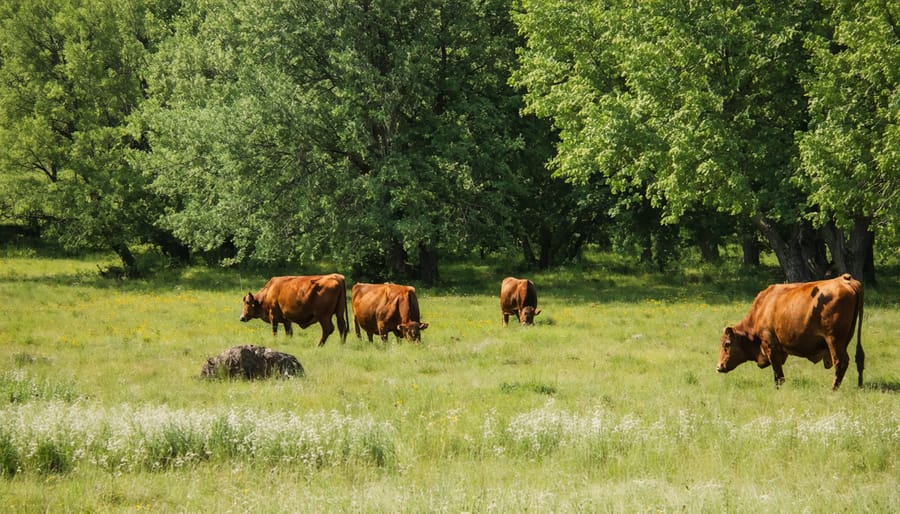
Forest Gardens for Market
Forest gardens designed for market production offer Canadian farmers a unique opportunity to diversify their income streams while building sustainable agricultural systems. Unlike traditional home-scale forest gardens, market-oriented designs focus on crops with proven commercial value and efficient harvesting methods.
In Alberta, several farmers have successfully implemented commercial forest gardens, including the Henderson Family Farm near Red Deer, which generates significant revenue from hazelnuts, saskatoons, and chokecherries. Their multi-layered system includes tall nut trees, fruit-bearing shrubs, and medicinal herbs that supply local markets and food processors.
To establish a market-oriented forest garden, focus on selecting hardy species with consistent yields and established market demand. Popular options for our climate include:
– Fruit trees: apples, pears, and Evans cherries
– Berry shrubs: haskap, saskatoons, and currants
– Perennial herbs: mint, oregano, and sage
– Mushrooms: oyster and shiitake on shade-tolerant logs
Successful market forest gardens typically require 2-5 years to reach profitable production levels. Planning for efficient harvesting is crucial – consider wide spacing between rows and group similar plants together to streamline picking operations. Many Alberta producers find success by partnering with local restaurants, farmers’ markets, and value-added processors to ensure stable sales channels.
Remember to start small and scale gradually, allowing time to understand market demands and optimize your growing systems. Regular consultation with local agricultural extension services can provide valuable guidance on species selection and marketing strategies.
Getting Started with Agroforestry
Planning Your System
Planning a successful agroforestry system requires careful consideration of your specific land conditions, climate, and farming goals. Let’s break down the essential steps to create a solid foundation for your project.
Start by conducting a thorough site assessment. Map out your property, noting soil types, drainage patterns, and existing vegetation. Consider factors like wind direction, sun exposure, and seasonal changes typical to Alberta’s climate. This information will help you choose tree species and crops that will thrive in your specific conditions.
Next, define clear objectives for your agroforestry system. Are you primarily focused on windbreak protection, increasing biodiversity, or developing new income streams? Your goals will shape the design and components of your system. For example, if you’re interested in maple syrup production, you’ll need different spacing and species selection than if you’re creating shelter belts for livestock.
Create a detailed timeline for implementation. Most successful agroforestry projects in Alberta start small and expand gradually. Consider breaking your project into manageable phases over 3-5 years. This approach allows you to learn from experience and adjust your strategies as needed.
Develop a budget that accounts for initial establishment costs, ongoing maintenance, and potential returns. Include expenses like seedlings, protection materials, irrigation systems, and labour. Remember to research available grants and support programs through local agricultural organizations.
Connect with experienced agroforesters in your region. The Alberta Agroforestry Network offers valuable mentorship opportunities and can connect you with farmers who have successfully implemented similar systems. Their practical insights can help you avoid common pitfalls and optimize your design.
Finally, create a monitoring plan to track your system’s progress. Document growth rates, soil health changes, and biodiversity indicators. This data will help you make informed decisions about future expansions and adjustments to your system.
Remember, flexibility is key. Be prepared to adapt your plan based on changing conditions and new learning experiences. Success in agroforestry comes from careful planning combined with responsive management.
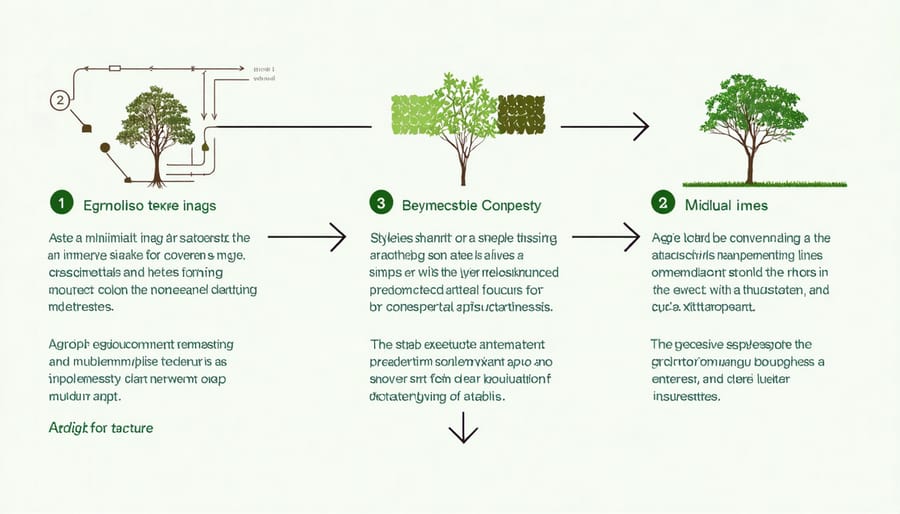
Funding and Support Resources
Implementing agroforestry systems in Alberta is supported by various funding opportunities and resources designed to help farmers transition successfully. The Growing Forward 2 program, in partnership with Agriculture and Agri-Food Canada, offers significant financial assistance for environmental stewardship projects, including agroforestry initiatives. Farmers can access available farming grants that cover up to 70% of eligible costs for establishing windbreaks, silvopasture systems, and riparian buffers.
The Agricultural Service Board in Alberta provides technical support and guidance through local fieldmen who can assist with project planning and implementation. Additionally, the Agroforestry and Woodlot Extension Society (AWES) offers workshops, field days, and one-on-one consultations to help farmers develop successful agroforestry systems.
For Indigenous communities, the Indigenous Agriculture and Food Systems Initiative provides specialized funding and support for traditional agroforestry practices. The Canadian Agricultural Partnership (CAP) also offers cost-sharing programs specifically designed for environmental sustainability projects.
Local conservation authorities frequently partner with farmers to provide both funding and expertise. The Alternative Land Use Services (ALUS) program compensates farmers for maintaining and establishing ecosystem services, including agroforestry projects. Resources are also available through Agriculture Financial Services Corporation (AFSC), which provides loans and insurance options tailored to agroforestry initiatives.
For ongoing support, the Alberta Woodlot Extension Program maintains a network of demonstration sites where farmers can learn from established systems and connect with experienced practitioners. Regular workshops and field days are organized throughout the province, providing opportunities for hands-on learning and community building.
Common Challenges and Solutions
While agroforestry offers numerous benefits, Alberta farmers often encounter several challenges when implementing these systems. Understanding and preparing for these obstacles can help ensure success in your transition to agroforestry.
One common challenge is the initial investment of time and resources. Establishing trees and shrubs requires careful planning and upfront costs. To address this, many farmers start with small pilot projects and gradually expand their systems. Provincial cost-sharing programs and agricultural grants can help offset these initial expenses.
Weather extremes in Alberta, particularly late spring frosts and winter damage, can affect young trees. Selecting hardy, climate-appropriate species and using windbreaks or protective structures during establishment can significantly improve survival rates. Native species like trembling aspen and white spruce have proven particularly resilient in our climate.
Competition between trees and crops for water and nutrients presents another challenge. Proper spacing and regular pruning help manage this issue. Some farmers have found success with deep-rooted trees that access different soil layers than their crops, reducing competition while improving overall soil structure.
Knowledge gaps can be intimidating, but Alberta’s strong agricultural community offers valuable support. Local extension services, farmer-to-farmer mentorship programs, and workshops provided by organizations like the Agroforestry and Woodlot Extension Society help bridge this gap. Many experienced agroforesters are willing to share their insights and lessons learned.
Managing harvest logistics in integrated systems requires additional planning, but can be overcome through careful design and timing of operations. Modern equipment adaptations and innovative harvesting techniques have made this easier than in past years.
Remember, these challenges are not insurmountable. With proper planning, community support, and a gradual implementation approach, farmers across Alberta are successfully incorporating agroforestry into their operations.
Building Community Through Agroforestry
Agroforestry systems do more than enhance environmental sustainability – they create vibrant social connections that strengthen rural communities. Across Alberta, farmers implementing agroforestry practices are discovering the power of building agricultural communities through shared knowledge and resources.
These systems naturally encourage collaboration among neighboring farms. When farmers integrate trees and crops, they often share equipment, labour, and expertise during planting and harvest seasons. This cooperation extends beyond immediate neighbors to create networks of knowledge-sharing that benefit entire regions.
Local food security also improves as agroforestry systems provide diverse products throughout the year. Farmers’ markets become more vibrant with seasonal offerings of nuts, fruits, and forest products alongside traditional crops. These market spaces serve as community hubs where producers and consumers connect, strengthening local food relationships.
Educational opportunities flourish in agroforestry environments. Many Alberta farmers host field days and workshops, allowing others to learn from their experiences. School groups often visit these integrated systems, helping young people understand the connections between agriculture, forestry, and ecosystem health.
Indigenous knowledge plays a vital role in Canadian agroforestry practices. By incorporating traditional ecological wisdom and fostering partnerships with Indigenous communities, farmers can enhance their understanding of sustainable land management while building meaningful cross-cultural relationships.
The economic benefits of agroforestry extend throughout communities as diversified income streams support local businesses and create employment opportunities. Whether it’s processing value-added products or developing agritourism experiences, these systems help maintain the vitality of rural economies while fostering a shared sense of purpose among community members.
Agroforestry systems represent a powerful opportunity for Canadian farmers to enhance their land’s productivity while contributing to environmental sustainability. Throughout this article, we’ve explored how integrating trees and shrubs with conventional farming practices can create resilient agricultural systems that benefit both the farmer and the environment.
The success stories from Alberta farmers demonstrate that agroforestry is not just a theoretical concept but a practical solution that works in our climate. From windbreaks that protect crops and reduce soil erosion to silvopasture systems that provide shade for livestock and additional income streams, the benefits are clear and achievable.
As we face increasing climate uncertainties and economic pressures, adopting agroforestry practices can help diversify farm income, improve soil health, and create lasting environmental benefits. The initial investment in time and resources is balanced by long-term gains in productivity and sustainability.
We encourage you to take the first step by assessing your land’s potential for agroforestry implementation. Connect with local agricultural extension offices, join farmer networks, and consider starting with a small pilot project. Resources and support are available through provincial programs and experienced practitioners in your community.
Remember, every successful agroforestry system started with a single tree. By embracing these practices, you’re not just investing in your farm’s future – you’re contributing to a more sustainable and resilient Canadian agricultural landscape for generations to come.


